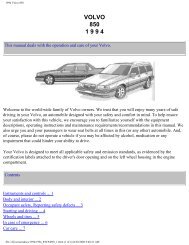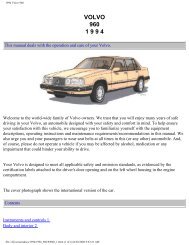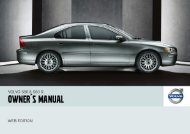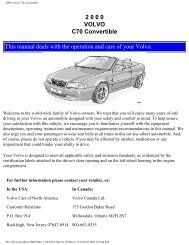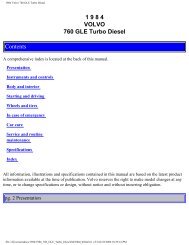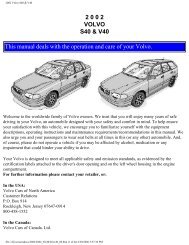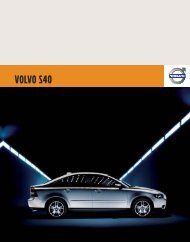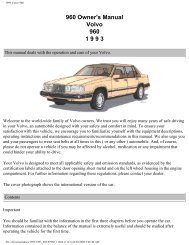V50 w646.book - ESD - Volvo
V50 w646.book - ESD - Volvo
V50 w646.book - ESD - Volvo
Create successful ePaper yourself
Turn your PDF publications into a flip-book with our unique Google optimized e-Paper software.
10 Infotainment system<br />
Radio functions<br />
10<br />
Storing autostored presets in another<br />
memory<br />
An autostored preset can be transferred to<br />
the FM or AM memory.<br />
– Briefly press AUTO (7).<br />
Auto appears in the display.<br />
– Press a preset button.<br />
– Press the button under which the station<br />
will be stored and hold it depressed until<br />
the message Station stored appears in<br />
the display.<br />
The radio exits Auto mode and the stored<br />
station can be selected as a preset.<br />
Scanning<br />
SCAN (4) automatically searches for strong<br />
AM or FM stations. When a station is found, it<br />
is played for approx. eight seconds before<br />
scanning is resumed.<br />
Activating/deactivating Scan<br />
– Select wavelength using AM/FM.<br />
– Press SCAN to activate.<br />
SCAN appears in the display. Cancel with<br />
SCAN or EXIT.<br />
Storing a station<br />
A desired station can be stored as a preset<br />
while Scan is active.<br />
– Press a preset button and hold it depressed<br />
until the message Station stored<br />
appears in the display.<br />
Scan is interrupted and the stored station<br />
can be selected as a preset.<br />
RDS functions<br />
Radio Data System – RDS links FM transmitters<br />
into a network. An FM transmitter in such<br />
a network sends information that gives an<br />
RDS radio the following functions:<br />
• Automatically switches to a stronger<br />
transmitter if reception in the area is poor.<br />
• Searches for programme form, such as<br />
traffic information or news.<br />
• Receives text information on current radio<br />
programme.<br />
Some radio stations do not use RDS or only<br />
some if its functionality.<br />
Programme functions<br />
In FM mode, the radio can search for stations<br />
with certain programme types. If a desired<br />
programme type is found, the radio can<br />
switch stations, interrupting the audio source<br />
currently in use. For example, if the CD player<br />
is in use, it is paused. The interrupting transmission<br />
is played at a preset volume; see<br />
page 214. The radio returns to the previous<br />
audio source and volume when the set programme<br />
type is no longer broadcast.<br />
The programme functions alarm (ALARM),<br />
traffic information (TP), news (NEWS), and<br />
programme types (PTY) interrupt one another<br />
in order of priority, where alarm has the<br />
highest priority and programme types has<br />
the lowest. For further programme interruption<br />
settings, see EON and REG on<br />
page 214. The programme functions are<br />
modified via the menu system, see page 208.<br />
Returning to the interrupted audio<br />
source<br />
Press EXIT to return to the interrupted audio<br />
source.<br />
Alarm<br />
This function is used to warn of serious accidents<br />
and catastrophes. The alarm cannot<br />
be temporarily interrupted or deactivated.<br />
The message ALARM! appears on the display<br />
when an alarm message is transmitted.<br />
Traffic information – TP<br />
This function allows traffic information<br />
sent within a set station’s RDS<br />
network to break through. TP indicates<br />
that the function is activated.<br />
If the set station can send traffic information<br />
then appears on the display.<br />
212




